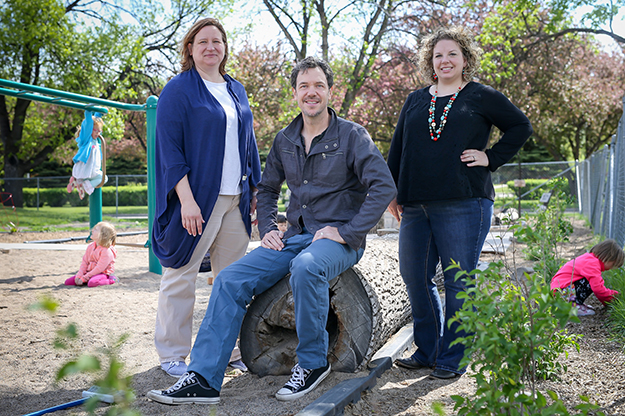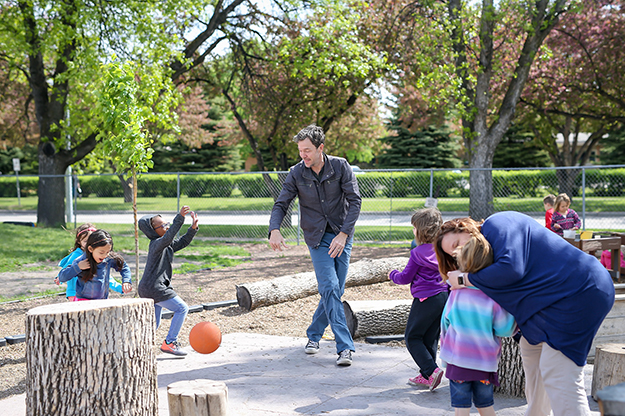Natural growth
UND education researchers partner with local children’s center to study benefits of outdoor learning

When Joshua Hunter was a boy growing up in southern Indiana, his most transformative moments were hiking through the woods near his home, digging fossils out of the limestone.
These early outdoor experiences set the UND assistant professor of Educational Foundations and Research on a nature-based professional path—as a park ranger, a naturalist and environmental educator. His academic world now revolves around outdoor education, and the role that nature plays in the learning experience of children.
“When adults talk about why they think these things are important, it links back to early childhood memories, and that’s the key—developing affect at a young age, so that people want to maintain those memories and do those things again and again,” Hunter said.
Hunter’s expertise was harnessed as the University Childhood Learning Center (UCLC) began the development of its outdoor classroom two years ago. Hunter was included on the advisory board that would collaborate with the national Nature Explore program to turn its area of swings and slides into one of natural log obstacles, science tables, vegetable planter boxes and water play systems.
“The primary mission is to expose children to nature in a natural way,” said UCLC Director Dawnita Nilles, who was part of the team that broke ground on the project in June 2015. “It’s not a playground that’s full of metal, but instead, an outdoor space that becomes a learning environment.”
During the process of designing and building the outdoor classroom for pre-kindergarten learning, Hunter realized he and his graduate students had a number of research opportunities in front of them. While Hunter could focus on curriculum, pedagogy and the use of nature, grad students like Cherie Graves could lead separate, yet connected, inquiries.
“I was interested in social interactions, creativity, learning and developing through play, gaining confidence and taking risks,” explained Graves, who is also a UND Occupational Therapy instructor. “Our original plan was very simple—to explore the attitudes and beliefs of parents and teachers regarding children’s engagement in nature play and outdoor exploration. As we collected data, the findings spurred areas of further interest.”

Creativity and risk
Through observation and interviews, Hunter and Graves found that the new learning space was sparking more engagement between the children. Instead of waiting in line for a swing, the kids were actively working together to solve problems—like crafting water diversions or sorting and categorizing natural elements.
“Teachers are talking about what seems to be an explosion of creativity in the space for children, things that they hadn’t necessarily noticed before. I think that’s the really exciting thing,” Hunter said.
Their studies also noted a shift in the thinking of parents. When the outdoor classroom was first being used, Nilles said some parents were worried about the lack of structure and the risks involved—the natural space meant kids would be digging in mud, climbing on logs, etc. But as they saw their children deeply engaged in play and learning, those concerns faded. And, Hunter adds, the risk is all a part of the learning process.
“To not allow children to fail, to not allow them to take risks and help them understand what to do in risky situations, creates people who are not able to function when they’re in environments that they’re not familiar with,” he said. “We limit so much in the things that we allow children to do. These types of experiences are a counterweight to that.”
Outdoor time isn’t slowing Nilles’ teachers and students down. Documented assessments show that the children are meeting the benchmarks necessary for admittance to kindergarten, and those standards are being met without sitting at a table and completing a worksheet. Instead, the youngsters are actively engaged in real-world critical thinking.
Moms and dads are happy to be involved in the open-air innovation.
“They can see there’s research going on that’s benefiting the global community—not just locally,” Nilles said. “It shows them something must really be going on, if it can be researched and reported to someone. It gives it another level of validity.”
Expanding the effort
Hunter and Graves are starting to wrap up their data collection. Combined with other research in the field, they hope to illuminate the scholastic importance of connecting young people to nature.
“The research shows several things happen when children are engaged holistically—kinesthetically, cognitively and emotively. They achieve higher results on tests,” Hunter said. “We also know from research that with children that have behavioral problems or learning disabilities, these things can be compensated by experiences in the woods and being outside. So I think there’s nothing but good things that are gained.”
But even with these findings, Hunter says there has to be an alteration in the national education mindset—not only pre-k, but through high school. He believes, when it comes to getting students outdoors for learning experiences, American schools are behind the curve comparatively with European schools, Australian schools, and other places that have similar socioeconomic demographics.
“I think that most teachers feel so constrained by the standards and the curriculum that’s in place that this idea of going outside seems to take them in a far different direction,” he said. “They’re being held accountable on what children know based on high-stakes tests, and nothing outdoors is being tested on that.”
Hunter adds that there has been growing recognition by policymakers of outdoor learning’s importance, but it’s up to everyone keep the conversation moving forward in educational and political arenas.
“If this is really important to people, then they should make that known to whoever is in charge,” he said.


